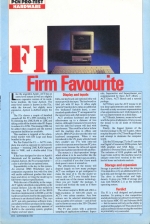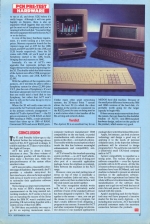
Personal Computer News
 1st September 1984
1st September 1984
Categories: Review: Machine
Author: Ian Scales
Published in Personal Computer News #076

Apricot F1 & F1e
The Firm Favourites
Like the ungolden Apple, ACT has an entry-level system as well as a slightly more expensive version of its workhorse machine, the basic Apricot. The entry-level system is known as the F1e, while the low-end, but slightly more expensive, Apricot is dubbed simply the F1.
The F1e shaves a couple of hundred pounds off the F1's £995 excluding VAT by slimming the 256K RAM to 128K and taking a side off the double-sided F1 floppy to reduce it to 315K. The missing 128K can be added when required and the normal expansion facilities are available.
This machine is targeted at the educational market with DR Logo and Basic bundled in the price.
We Pre-Tested the F1 - ACT's complete low-end (as opposed to entry-level) product - boasting 256K RAM expandable to 768K, and a double-sided 3.5" floppy.
It has been designed to take on Apple's Macintosh and IIc machines. Like the original Apricot, the F1 is transportable - a case is provided as an optional extra.
Expandability is the key to this system. An external 10Mb Winchester and a companion expansion box with five slots will enable additional goodies like interfaces and drives to bring the model up to full-blown Apricot specifications.
With this sort of flexibility in the range, ACT rightly identified compatibility as the crucial element. Like the other models in the range, the F1 has had all the BIOS functions implemented in ROM so all the hardware presents itself to the applications software in an identical fashion. This, says ACT, not only guarantees software transportability between products in the range, but also leaves a respectable amount of RAM to the Operating System, graphics display and user space.
Display And Inputs
Infra-red keyboard and optional infra-red mouse provide the input. The keyboard is a tiled job with 92 keys. It offers eight 'general' function keys (plus an additional two 'dedicated' function keys), a non-standard upside-down 'T' arrangement for the cursor keys and a full numeric keypad.
ACT promises keyboard and mouse effectiveness up to a distance of two metres, although it remains to be seen how well the infra-red system will deal with interference. This could be a factor in how well the machine does in offices and schools. IBM's PCjr also uses the infra-red keyboard arrangement. When it was introduced in the US, many schools found they couldn't use TVs with infra-red controls or operate more than one PCjr in a given room because the infra-red signals from one machine interfered with another.
The mouse is a 'dual-operation' design which allows it to be used either like the Apple mouse (except that it uses no cable), or as a trackball if you don't have much desk space to move it around on.
The effectiveness of the mouse will depend largely on how many packages ACT can configure or get configured to make the most of it. On the model we tested, only ACT's own 'friendly' front-end made use of the mouse technology. Once you get 'inside' the package, it looked and worked the same as if there were no mouse.
The colour output is RGB and offers a high-resolution of 640x256 pixels on ACT's own colour monitor. Any four colours can be selected simultaneously from a palette of 16 colours - and all four can be shown at once in the 320x256 pixel resolution mode.
The F1 also comes with a generous sampling of applications software. Supercalc, Superwriter and Superplanner are complemented by three ACT efforts - ACT Diary, ACT Sketch and a tutorial package.
ACT Diary uses the ACT mouse to let you keep appointments and make reminders with a natty on-screen representation of an appointments card. Unfortunately, it isn't an improvement on a desk diary.
ACT Sketch, however, seems to be well worth the price of admission. It lets you use the mouse to do all kinds of freehand technical drawing.
Fianlly, the biggest feature of the tutorial package is the ACT game, where you play the part of ACT boss Roger Foster and attempt to dominate the computer world.
Like the XI (see page 27); the FI can also run Digital's Concurrent DOS system, full GSX graphics and GSX Basic - in addition to Personal Basic and DR Logo. The inclusion of GSX graphics and DR Logo bodes well for this machine (and its cheaper entry-level version) in the well-heeled home and schools markets.
Storage and Expansion
Storage is provided by either the integral 3.5" disk drive or by an additional drive or hard disk unit through the expansion box. The drive is double-sided and high-density. It gives you 720K of storage and runs with MSDOS 2.11 as the included Operating System.
Verdict
The F1 is a well-designed and pleasant machine. Its pricing is also competitive and should make it an attractive alternative to the Sanyo MBC-555 and Advance 86-B - but its success will rely on the ability to exploit all the gadgets ACT has stuck into it, and on software houses seeing the machine as potentially very successful.
This article was converted to a web page from the following pages of Personal Computer News #076.





